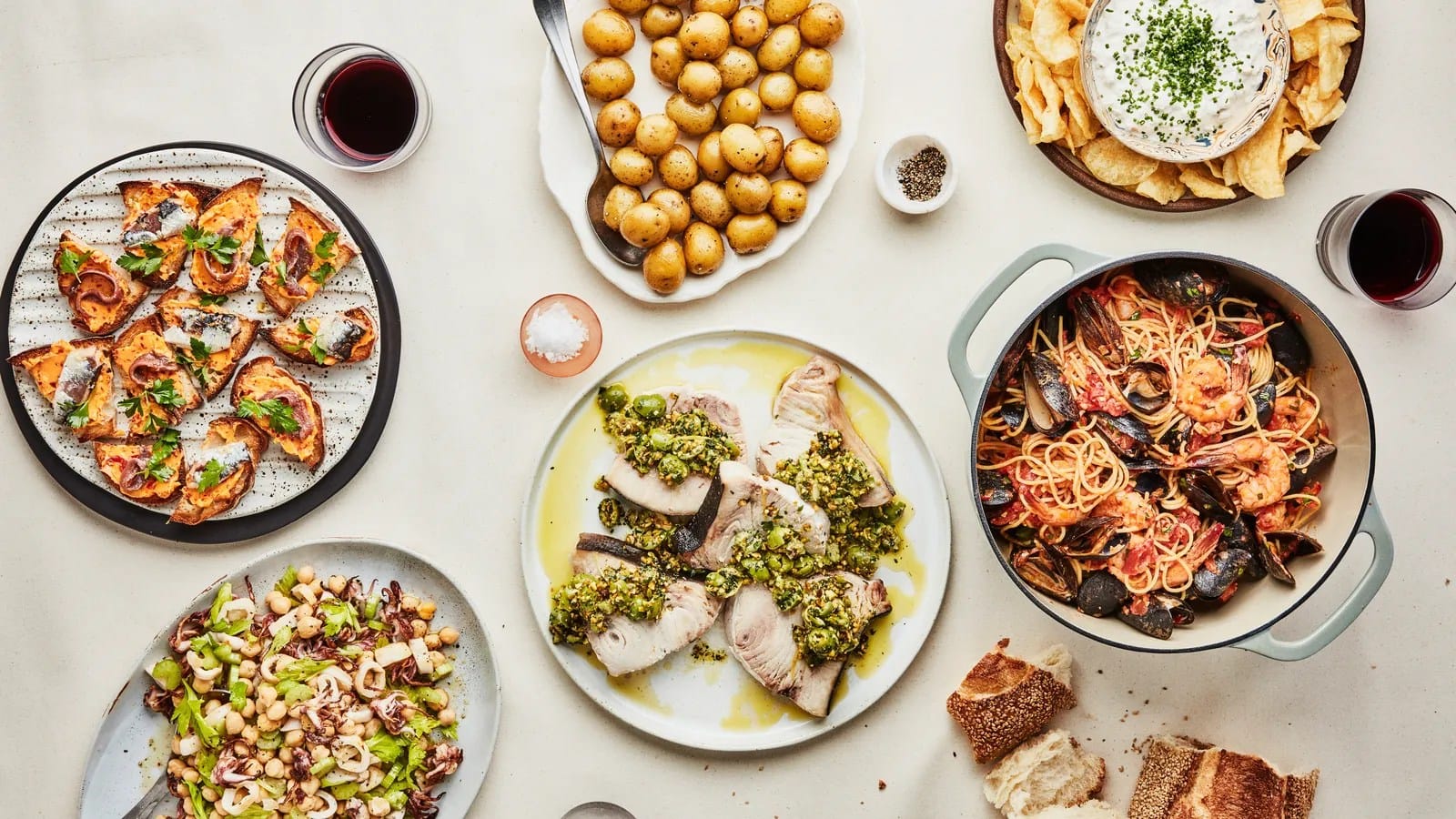Unlocking the Feast: A Culinary Journey Through Italy’s Seafood Heritage
The Feast of the Seven Fishes isn’t just a meal; it’s a culinary journey through Italy’s rich seafood heritage, enjoyed on Christmas Eve. While its exact origins are debated, the tradition likely stems from Southern Italy’s strong Catholic heritage, where abstaining from meat on Christmas Eve was customary. This celebration of abundance, symbolized by the number seven, has evolved over generations, becoming a cherished tradition for Italian-Americans.
Deconstructing the Traditional Menu: A Symphony of Flavors
While there’s no fixed menu for the Feast of the Seven Fishes, common elements provide a framework for a delicious and diverse spread. Here’s a glimpse into a traditional multi-course experience:
Appetizers: Igniting the Appetite
The feast typically begins with light, flavorful bites to whet the appetite. Popular choices include:
- Baked Stuffed Clams: Tender clams brimming with savory stuffing.
- Raw Oysters on the Half Shell: A classic delicacy for the adventurous palate.
- Shrimp Cocktail: Plump, juicy shrimp served with tangy cocktail sauce.
Salads: A Refreshing Counterpoint
A fresh, vibrant salad offers a refreshing counterpoint to the richer seafood dishes.
- Greens and Seafood Salad: A medley of crisp greens tossed with calamari, shrimp, or octopus.
Soups & Stews: Bowls of Comfort and Warmth
Hearty soups and stews are a staple of the Feast, providing warmth and comfort.
- Cioppino: An Italian-American fish stew brimming with flavor.
- Brodetto: An Italian fish stew with regional variations, each offering its own unique twist.
Pasta Course: An Italian Essential
No Italian feast is complete without a pasta course.
- Linguine with Clam Sauce: A classic pairing of delicate pasta with the briny flavor of clams.
- Lobster Ravioli: Rich, indulgent, and perfect for a special occasion.
- Seafood Risotto: Creamy risotto infused with the flavors of the sea.
Main Courses: Showcasing the Stars of the Show
The main courses often feature a variety of preparations, showcasing the versatility of seafood.
- Whole Roasted Fish: Baked, grilled, or fried, whole fish like branzino, snapper, or cod are popular choices.
- Stuffed Calamari: Tender calamari filled with savory stuffing and cooked to perfection.
- Shrimp Scampi: Succulent shrimp bathed in garlic butter sauce.
Palate Cleanser: A Refreshing Interlude
A light sorbet or a simple salad course helps cleanse the palate between courses, preparing you for the delicious dishes to come.
Dessert: A Sweet Ending to a Festive Feast
The feast culminates with traditional Italian sweets that provide a sweet ending to a memorable meal.
- Panettone: A sweet, dome-shaped bread studded with candied fruits and raisins.
- Struffoli: Crispy, bite-sized fried dough balls drizzled with honey and often adorned with sprinkles.
- Biscotti: Twice-baked cookies perfect for dipping in coffee or dessert wine.
Embracing Flexibility: The Beauty of Personalization
One of the most appealing aspects of the Feast of the Seven Fishes is its flexibility. While the traditional elements provide a framework, there’s ample room for personalization and adaptation.
Regional Variations: Exploring Culinary Diversity
Different regions of Italy boast their own interpretations of the Feast, offering a wealth of culinary inspiration.
- Southern Italy: Baccalà (salt cod) is prevalent, reflecting the region’s history and culinary traditions.
- Sicily: Pasta con le Sarde (pasta with sardines) is a beloved dish, showcasing the island’s unique flavors.
- Naples: Capitone Fritto (fried eel) is a popular choice, representing the region’s coastal cuisine.
- Venice: Brodetto (fish soup) takes center stage, highlighting the city’s lagoon-based culinary heritage.
Modern Adaptations: Honoring Tradition with a Contemporary Flair
Modern cooks often put their spin on traditional dishes, incorporating contemporary flavors, techniques, and ingredients. This fusion of old and new keeps the tradition fresh and exciting.
Vegetarian and Pescatarian Options: Inclusivity at Its Finest
For those who don’t eat meat but still want to partake in the Feast, there are plenty of delicious vegetarian and pescatarian options. Seafood-inspired vegetable dishes, plant-based pasta sauces, and meatless appetizers ensure that everyone feels included in the celebration.
Prepare Like a Pro: Tips for a Seamless Feast
Hosting a multi-course feast might seem daunting, but with a little planning and these helpful tips, you can ensure a stress-free and enjoyable Christmas Eve gathering:
Planning and Preparation: Your Keys to Success
- Create a Detailed Menu: Consider your guests’ preferences, dietary needs, and any family favorites you want to incorporate.
- Shop Strategically: Research local fish markets or seafood counters for the freshest catches. Don’t hesitate to ask your fishmonger for recommendations and cooking tips.
- Embrace Make-Ahead Magic: Prepare as much as possible in advance. Sauces, soups, and even some seafood preparations can be made ahead of time, leaving you with less to do on the day of the feast.
Enlist Help and Make It a Family Affair
- Delegate Tasks: Don’t be afraid to ask for help! Enlist family members or friends to assist with cooking, setting the table, or pouring drinks.
- Turn It Into a Tradition: Involve younger generations in the preparations, passing down family recipes and creating lasting memories.
Embrace the Spirit of the Feast
Ultimately, the Feast of the Seven Fishes is more than just a meal—it’s a celebration of family, heritage, and the joy of the holiday season. By embracing the spirit of the tradition—its flexibility, its diversity, and its focus on shared moments—you can create a memorable and meaningful Christmas Eve celebration.
- Discover Famous French Women: A History of Impact - April 2, 2025
- 2025 World Map: Unveiling Geopolitical Shifts & Risks - April 2, 2025
- Secure Your Future: Living Will vs. Last Will Guide - April 2, 2025

















1 thought on “The Ultimate Feast of the Seven Fishes Menu: Classic Recipes & Modern Twists”
Comments are closed.